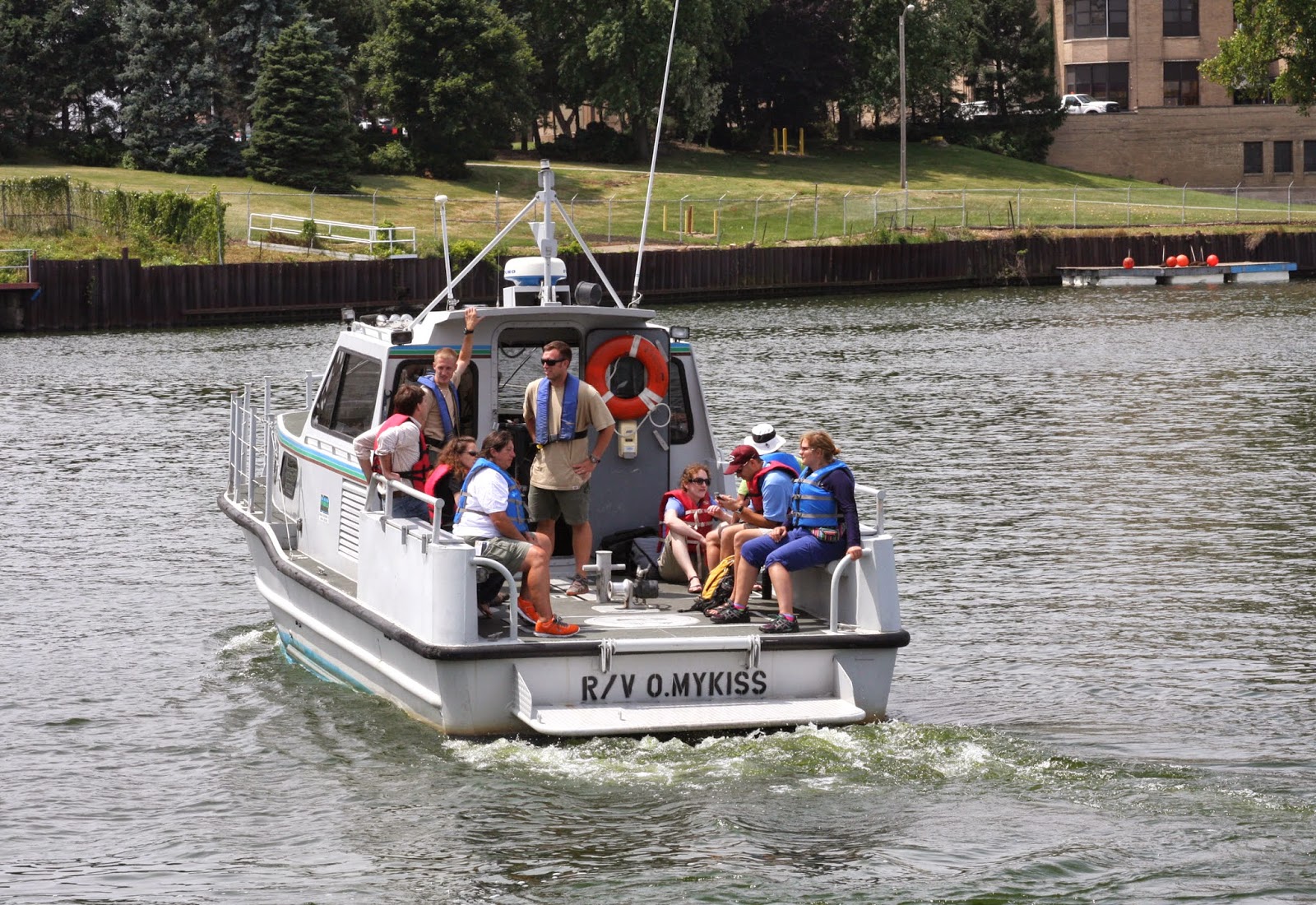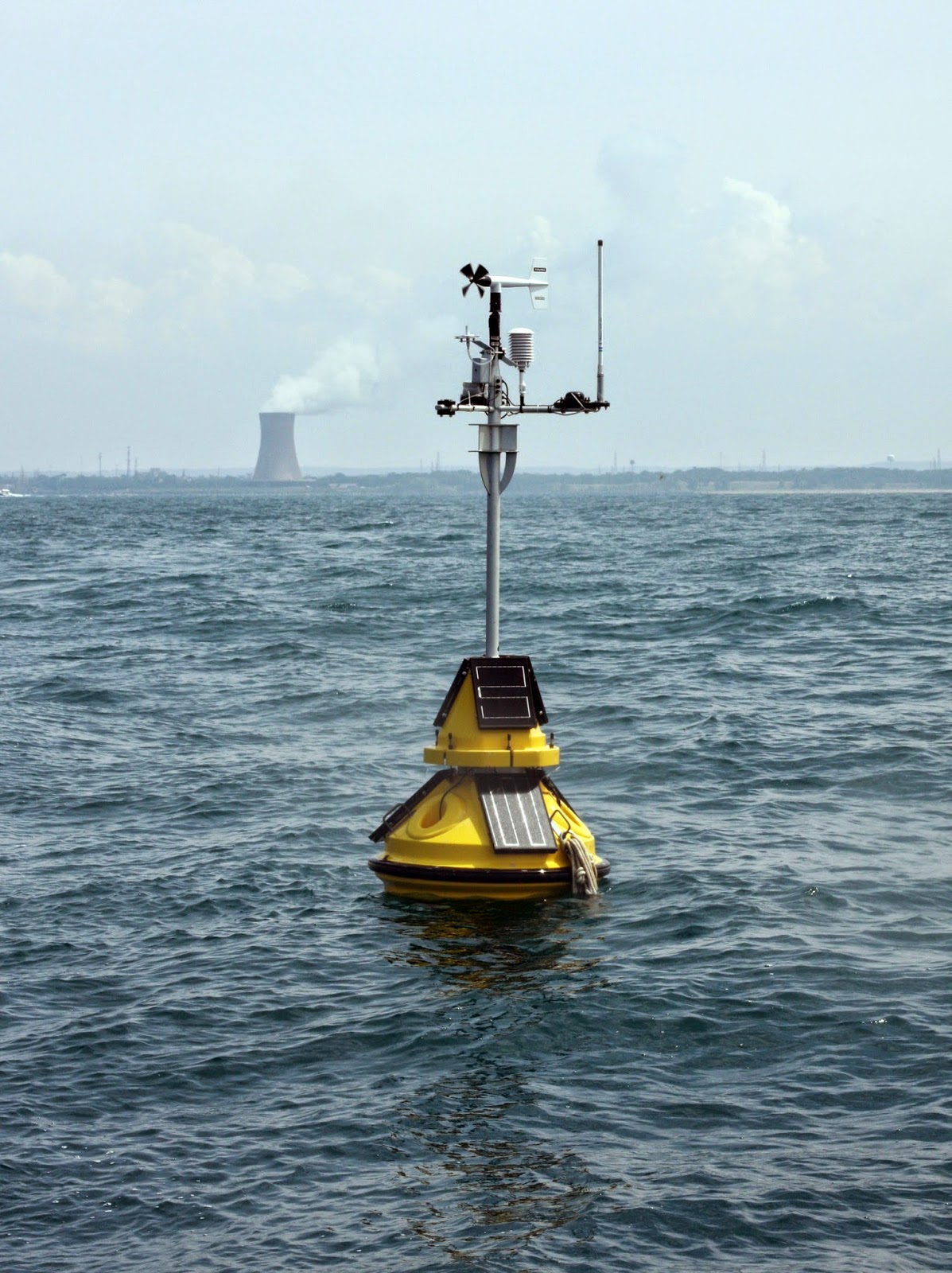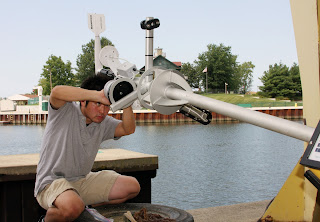December 2nd, 2014 by iisg_superadmin
A new environmental sensing buoy will be placed north of Chicago this summer, making it easier than ever for Illinois boaters and beach-goers to spend a fun, safe day on the water.
Like its counterpart in Michigan City, IN, the nearshore buoy will relay information on wave height and direction, wind speed, and air and surface water temperatures in near real time. A webcam will also make it possible to watch changing lake conditions first-hand.
This is the newest in a string of nearshore buoys along the Lake Michigan shoreline. In addition to allowing people track waves and temperatures, the data they collect will help officials warn beachgoers when contamination levels may make swimming unsafe. Researchers also rely on the real-time information to manage fisheries, monitor lake currents, and improve hazardous weather predictions.
The Illinois buoy, jointly operated by IISG and LimnoTech, is expected to go online in May. The project is funded by the Great Lakes Observing System through a grant from NOAA Coastal Storms.
August 15th, 2014 by iisg_superadmin
 Fourteen teachers from Illinois and Indiana are hard at work developing new science lessons that incorporate real-time data from the Michigan City buoy after a training workshop held last week at Purdue North Central.
Fourteen teachers from Illinois and Indiana are hard at work developing new science lessons that incorporate real-time data from the Michigan City buoy after a training workshop held last week at Purdue North Central.
During the day-long workshop, IISG’s education and research teams, along with Purdue University’s Cary Troy
, introduced teachers to the environmental monitoring buoy, the data it collects, and how researchers are using the data to better understand the nearshore waters of Lake Michigan.
 The highlight of the workshop for many was the boat ride four miles into Lake Michigan to see the buoy first-hand—in smaller groups due to the size of the boat. The trips also gave teachers the opportunity to talk more with researchers and staff from the Indiana Department of Natural Resources(DNR) about the buoy and other data collection methods used to monitor fisheries, understand lake dynamics, and improve water safety.
The highlight of the workshop for many was the boat ride four miles into Lake Michigan to see the buoy first-hand—in smaller groups due to the size of the boat. The trips also gave teachers the opportunity to talk more with researchers and staff from the Indiana Department of Natural Resources(DNR) about the buoy and other data collection methods used to monitor fisheries, understand lake dynamics, and improve water safety.
The teachers will work together to develop at least six curriculum activities that improve STEM education—science, technology, engineering, and math—and boost understanding of Great Lakes issues. These won’t be complete till early next year, but the teachers already have big ideas for how to integrate the buoy data into their classrooms.
Several hope to use information on wind speed and water currents to improve their weather units. Others plan to use data collected by the buoy’s thermistor chain, which measures temperatures at different depths, to pinpoint the likely habitats of specific fish species and determine whether invaders like Asian carp could make a home in Lake Michigan. Some even expressed interest in having students compare buoy data with environmental characteristics collected on land to better understand solar radiation and seasonal changes.
The final lesson plans will be available on the IISG website.
Funding for the workshop was provided in part by the Indiana DNR Lake Michigan Coastal Program. Special thanks to the DNR staff at the Michigan City field office for taking the participants out on the lake.
August 1st, 2014 by iisg_superadmin
Earlier this week, a new environmental monitoring buoy joined a chain of similar buoys that are increasing boating and swimming safety and helping anglers target specific species of fish from Ludington, MI to Michigan City, IN.
From Michigan Live:
 Deployed roughly two miles off the shores of South Haven on Wednesday, the buoy can distribute improved wind and wave observations in addition to measuring wind speed, wind direction, air temperature, relative humidity, solar radiation, water temperature and wave height among other variables.
Deployed roughly two miles off the shores of South Haven on Wednesday, the buoy can distribute improved wind and wave observations in addition to measuring wind speed, wind direction, air temperature, relative humidity, solar radiation, water temperature and wave height among other variables.
“Given South Haven’s strong connection to Lake Michigan I am excited for the addition of this station to the regional buoy network,” South Haven Mayor Robert Burr said in a statement. “The city’s goal is to provide area boaters, swimmers, and water safety professionals with up-to-date lake conditions. Conditions on the big lake can change fast and we want everyone to be prepared when venturing out on the water.
Click on the link above to read the complete article. And visit our buoy website to learn more about how real-time data is helping weather forecasters and researchers better understand the nearshore waters of Lake Michigan.
**Photo: Boaters and swimmers enjoy the water at South Haven Beach
July 15th, 2014 by iisg_superadmin
Boaters, anglers, and swimmers, you many want to think twice before heading out into Lake Michigan today. Forecasters are predicting waves swells as high as 7 ft, creating dangerous conditions for any one in water.
The high waves are the result of an unusual weather pattern expected to continue into tomorrow. A small piece of the polar vortex has dropped down to the southern Great Lakes, bringing fall-like weather to parts of Michigan, Wisconsin, Illinois, and Indiana.

The cool air may be a welcomed break from July heat, but the shifting weather is not without its downsides. Right now, parts of the lake are actually warmer than the air above it, creating the perfect conditions for waterspouts. The wave swells created by gusty winds also bring a higher chance of rip currents, especially along Michigan’s western shore.
Whether you are planning a trip to the lake or not, you can track wave height and other lake conditions in southern Lake Michigan as the strange weather continues with the IISG real-time buoy.
*The week’s strange weather brings a chance of waterspouts like this one captured near Winthrop Harbor in 2013. Photo by Phil Mathis.
June 6th, 2014 by iisg_superadmin
The Michigan City buoy returned to the nearshore waters of Lake Michigan on June 5—this time with an upgrade that boaters, anglers, and researchers have been eagerly awaiting. In addition to broadcasting real-time data on wave height and direction, wind speed, and air and surface water temperatures, the improved buoy now relays water temperatures at different depths.
The sensor chain, which measures water temperatures approximately every 3 ft. from the surface to the bottom of the lake, will help kayakers know when the water is warm enough to paddle out and make it easier for anglers to find and catch their favorite fish. A more comprehensive picture of nearshore water temperatures is also vital for research on fisheries and nearshore hydrodynamics.
“We’ve been getting a lot of positive feedback asking us when the buoy will be in the water again,” said Carolyn Foley, IISG assistant research coordinator. “And they’re all excited to hear that we’ve added a temperature chain to our setup. The nearest buoy with a similar chain is about 30 miles away.”
Real-time data will be available on IISG’s website until the buoy is pulled out for the winter in mid-October. The site currently shows snapshots of lake conditions—updated every 10 minutes—as well as trends over 24-hour and 5-day periods. Buoy-watchers can also download raw historical data at NOAA’s National Data Buoy Center.
Later this summer, IISG will be hosting a workshop designed to help educators develop science, math, and stewardship projects using the real-time buoy data. The workshop is scheduled for August 6 at Purdue University North Central.
October 31st, 2013 by Irene Miles
The Michigan City real-time monitoring buoy, jointly owned and operated by Illinois-Indiana Sea Grant and the Purdue University Department of Civil Engineering, is out of the water for the 2013 season. This year, the buoy was deployed for 154 days, reporting data every 10 minutes around-the-clock. Over 3,400 people visited the buoy website during deployment, with an average of 18 hits per day. As one user put it, “Many, many of us have found the information as nothing less than terrific! Sailors like myself, fisherman like my dock neighbor, and so many pleasure boaters from Michigan City, Burns Harbor like to know what to expect once we leave the harbors.”
Buoy-watchers will have more to look forward to in 2014, as this winter the buoy will be getting an upgrade. Thanks in part to a grant from the Indiana Department of Natural Resources Lake Michigan Coastal Program awarded to IISG’s Tomas Hӧӧk, the buoy will broadcast real-time temperatures at different depths during the 2014 season and beyond. The buoy has always collected surface water temperature, but now it will also collect temperatures approximately every three feet from the surface to the bottom of the lake.
“We are very excited to install this chain of temperature loggers”, said Carolyn Foley, IISG assistant research coordinator who will help implement the new chain. “A number of groups told us they would use this information, from kayakers wanting to know if it’s warm enough to go for a paddle to anglers wanting to know where the best fishing will be.”
In addition to installing the new temperature loggers, IISG education staffers Terri Hallesy and Robin Goettel will work with Indiana educators to develop data-based lesson plans. IISG outreach staff, including Angela Archer and Leslie Dorworth, will also attend at least one outdoor show in northwestern Indiana to get direct feedback on ways to improve the buoy website for future seasons.
We would like to hear from anyone who uses the buoy data, particularly anglers, paddlers, and others who use southern Lake Michigan for recreation, as well as educators interested in using buoy data in their classrooms. If you 1) are an educator in grades 8-12 interested in participating in a workshop to acquire data sets for teaching and to develop lesson plans with buoy data, 2) have feedback related to improving the buoy website, and/or 3) would like to suggest an outdoor show for us to attend, please send us an email (iisg@purdue.edu) with “Buoy feedback” in the subject line. We expect to redeploy buoy in mid-May 2014.
Special thanks to the staff of the Indiana DNR Michigan City Field Office for their help deploying and retrieving the buoy.
July 3rd, 2013 by Irene Miles
If you’re headed out to enjoy the weather and the outdoors this holiday weekend, you may want to balance swim time with some time on the beach as water temperatures look to be below average in some areas of Lake Michigan.
“In contrast to air temperatures forecast in the 80s, Lake Michigan water won’t warm up in time for the Thursday holiday, according to the National Weather Service office in Grand Rapids.
 Water temperatures in Lake Michigan are 10 to 15 degrees colder than they were this time in 2012 and 5 to 10 degrees colder than they were in 2011, according to meteorologist Evan Webb. He said it’s a product of the cool spring this year.”
Water temperatures in Lake Michigan are 10 to 15 degrees colder than they were this time in 2012 and 5 to 10 degrees colder than they were in 2011, according to meteorologist Evan Webb. He said it’s a product of the cool spring this year.”
Water temperatures may be warmer or cooler at other points on the lake, and there are a number of sites to keep up to date on the conditions. If you’re planning to spend your time near the waters around Michigan City, Indiana, for instance, you can get current and recent nearshore conditions from the buoy operated by Purdue University and Illinois-Indiana Sea Grant.
However you spend time this holiday weekend, enjoy the sights and scenery safely.
June 4th, 2013 by Irene Miles
 Swimmers, boaters, and anglers visiting Indiana’s coastline this summer will again be able to learn about conditions in Southern Lake Michigan thanks to real-time data collected by the Michigan City buoy. The buoy, launched for the first time last fall, returned to its post four miles from shore last week to collect data on wave height and direction, wind speed, and air and surface water temperatures. It will stay in the water until November.
Swimmers, boaters, and anglers visiting Indiana’s coastline this summer will again be able to learn about conditions in Southern Lake Michigan thanks to real-time data collected by the Michigan City buoy. The buoy, launched for the first time last fall, returned to its post four miles from shore last week to collect data on wave height and direction, wind speed, and air and surface water temperatures. It will stay in the water until November.
The relaunch comes just in time to help make summer trips to Michigan City and the Indiana dunes safer. Throughout the season, scientists at the National Weather Service (NWS) in northern Indiana will use wave height and frequency data collected by the buoy to better anticipate likely locations of strong waves and rip currents that cause dangerous swimming conditions. The only one of its kind in the Indiana waters of the lake, the Michigan City buoy gives forecasters access to historically unavailable nearshore data where conditions are much different than at the center of the lake. Real-time data from the buoy has already helped NWS improve their wave height forecasts.
 “This information is vital for NWS forecasters to access and accurately forecast the potential for dangerous swimming and boating conditions along southern Lake Michigan,” said John Taylor, a meteorologist with the NWS office in northern Indiana. “Our hope is that by accurately forecasting when high waves and rip currents along the shoreline will result in dangerous swimming conditions, we can reduce the number of tragic drownings that occur in these waters every summer.”
“This information is vital for NWS forecasters to access and accurately forecast the potential for dangerous swimming and boating conditions along southern Lake Michigan,” said John Taylor, a meteorologist with the NWS office in northern Indiana. “Our hope is that by accurately forecasting when high waves and rip currents along the shoreline will result in dangerous swimming conditions, we can reduce the number of tragic drownings that occur in these waters every summer.”
The site lets visitors see real-time snapshots of lake conditions—updated every 10 minutes—as well as trends over 24-hour and 5-day periods.
And this year, the Michigan City buoy joins the ranks of environmental monitors that contribute to NOAA’s National Data Buoy Center. The addition makes it possible for people to easily access data older than five days and track trends over longer periods of time. This archived data is particularly important for researchers and natural resource managers who rely on the buoy’s data to improve weather forecasts, protect water quality, and predict where best to fish.
The buoy launch also coincides with Rip Current Awareness Week, and is just one piece of a larger effort to protect people from the dangers of rip currents. Visit the Rip Current Awareness Week website to learn more about rip currents and what you can do to protect yourself this summer.





